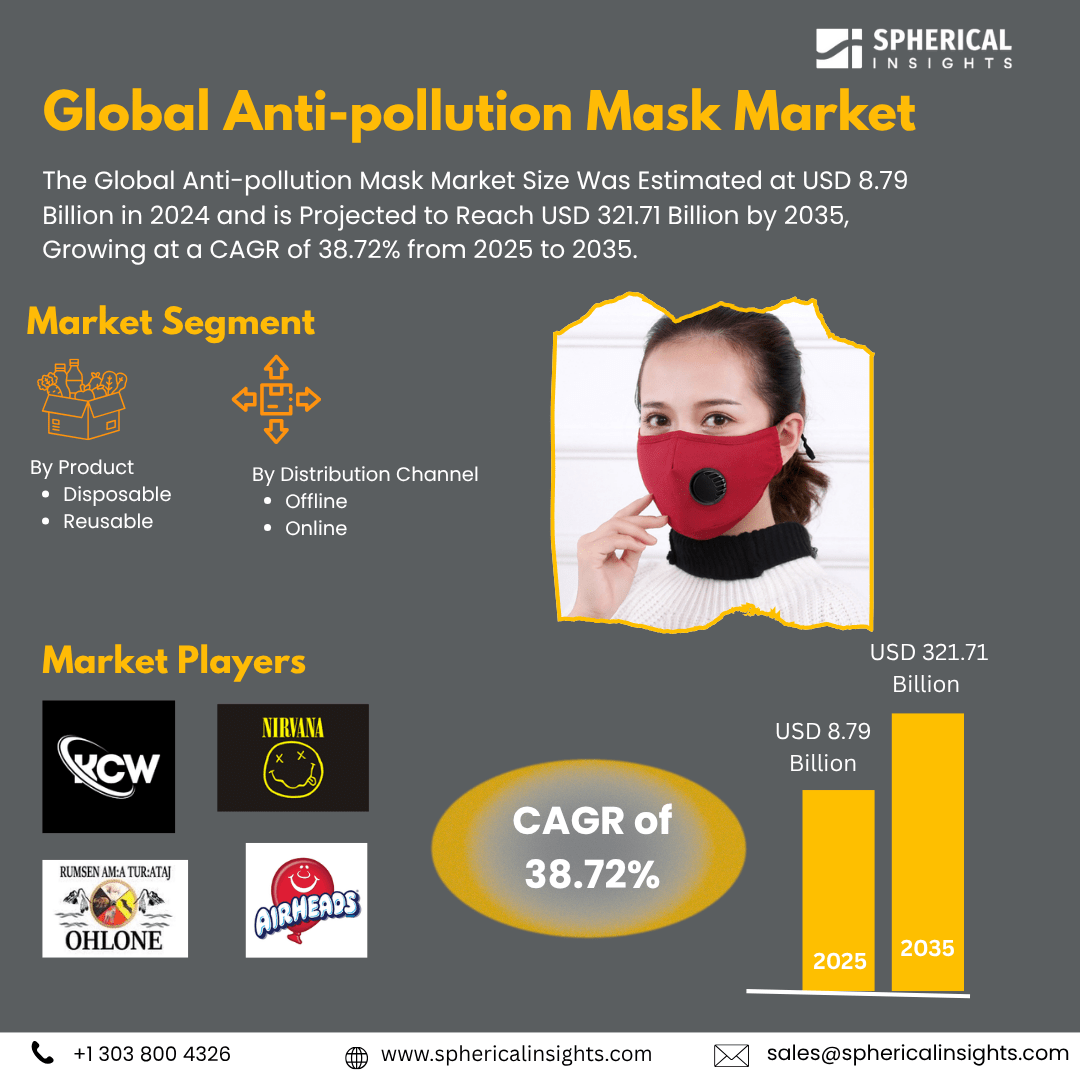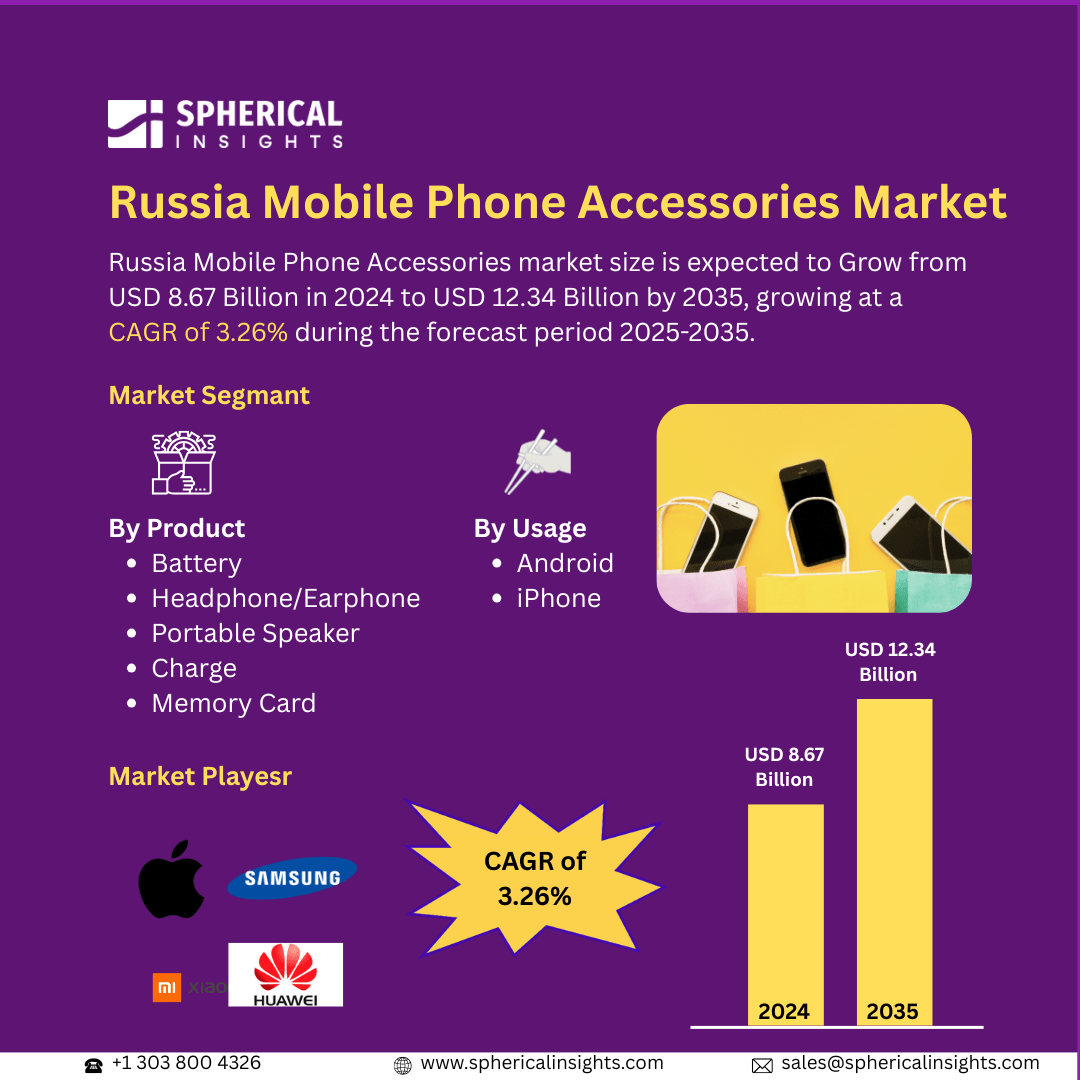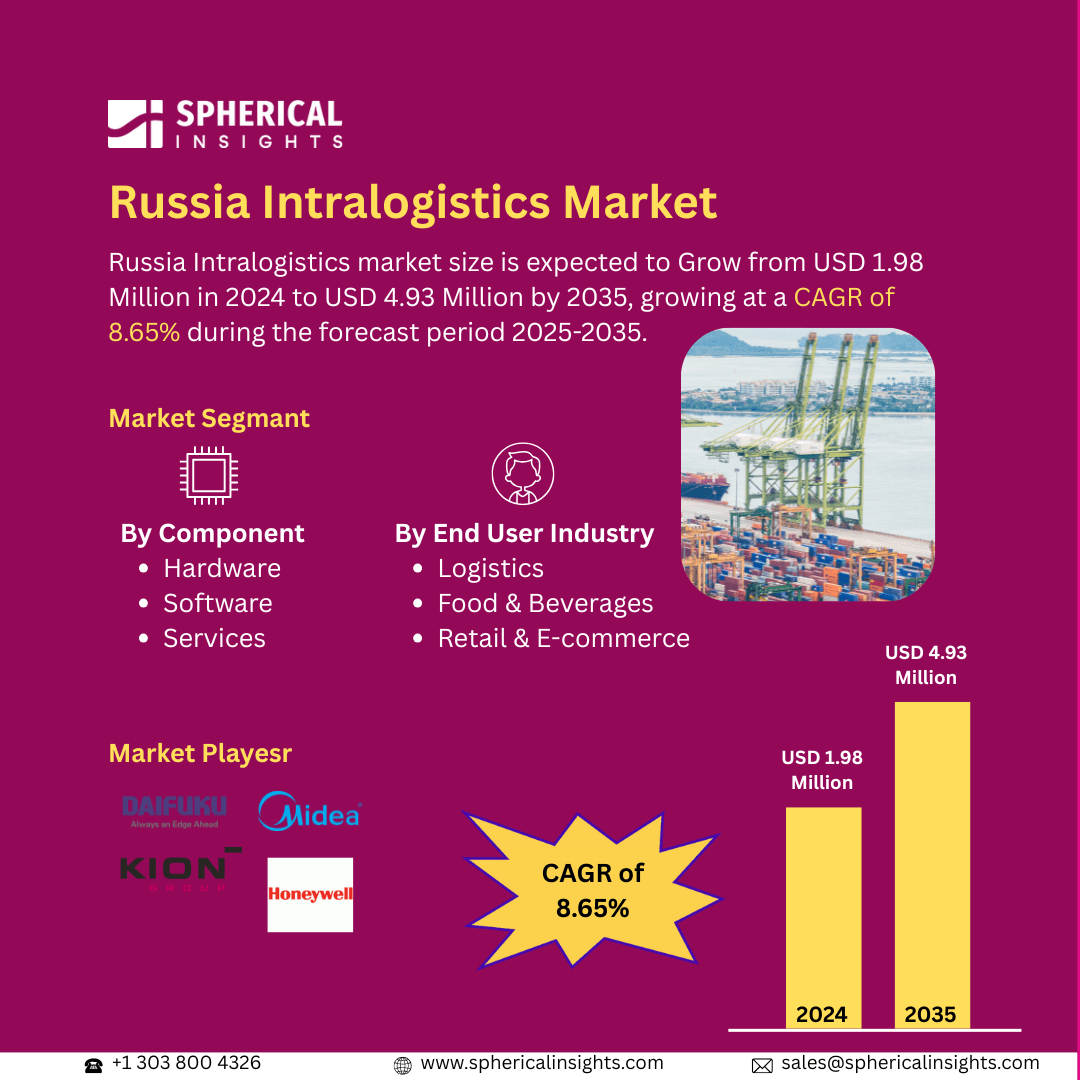Anti-pollution Mask Market Summary
The Global Anti-pollution Mask Market Size Was Estimated at USD 8.79 Billion in 2024 and is Projected to Reach USD 321.71 Billion by 2035, Growing at a CAGR of 38.72% from 2025 to 2035. The market for anti-pollution masks is primarily driven by factors such as rising air pollution levels, increasing health awareness, urbanization, industrialization, government regulations, and the growing demand for respiratory protection.
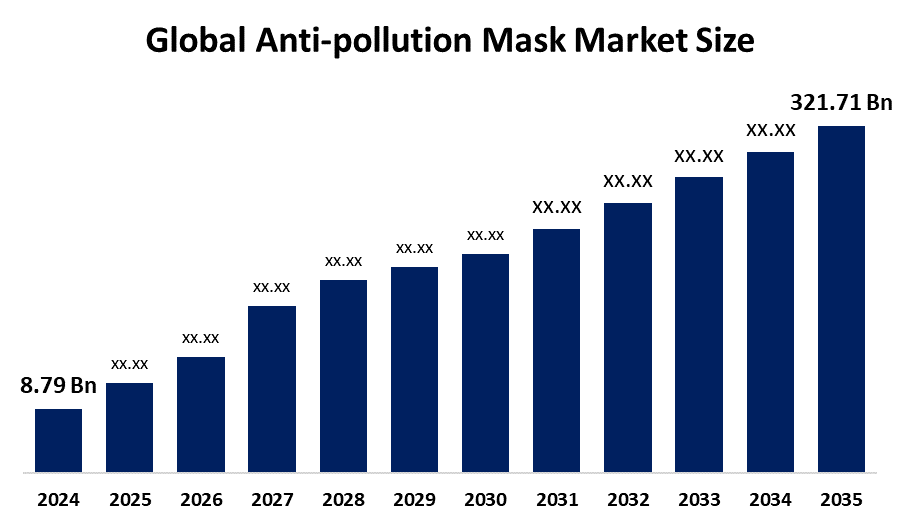
Key Regional and Segment-Wise Insights
- In 2024, the Asia Pacific held the largest revenue share of over 33.6% and dominated the market globally.
- In 2024, the disposable segment had the highest market share by product, accounting for 52.5%.
- In 2024, the offline segment had the biggest market share by distribution channel.
Global Market Forecast and Revenue Outlook
- 2024 Market Size: USD 8.79 Billion
- 2035 Projected Market Size: USD 321.71 Billion
- CAGR (2025-2035): 38.72%
- Asia Pacific: Largest market in 2024
The industry segment that produces and distributes protective face masks against airborne pollutants is referred to as the anti-pollution mask market. People use these masks primarily to stop respiratory diseases that develop from prolonged contact with polluted air in cities and industrial zones. Market demand is increasing because urbanization and vehicle emissions, together with industrial activities and construction operations, produce rising levels of air pollution throughout the world. Market growth occurs due to rising respiratory disease cases, including asthma, alongside increased public understanding of the dangers of poor air quality. The market receives influence from customers seeking fashionable reusable masks that protect while maintaining comfort, along with style.
The market for anti-pollution masks depends heavily on government initiatives, together with advancements in technology. The effectiveness and user experience are being improved by innovations, including multi-layer filtration, activated carbon filters, and smart masks with sensors to track breathing patterns and air quality. The incorporation of nanotechnology into filter media enables better performance of masks against ultra-fine particles. Various regional authorities carry out initiatives to improve air quality by implementing pollution control standards and distributing protective masks with financial support during times of high pollution. The combination of public-private partnerships with these programs leads to sustainable market growth and faster product adoption.
Product Insights
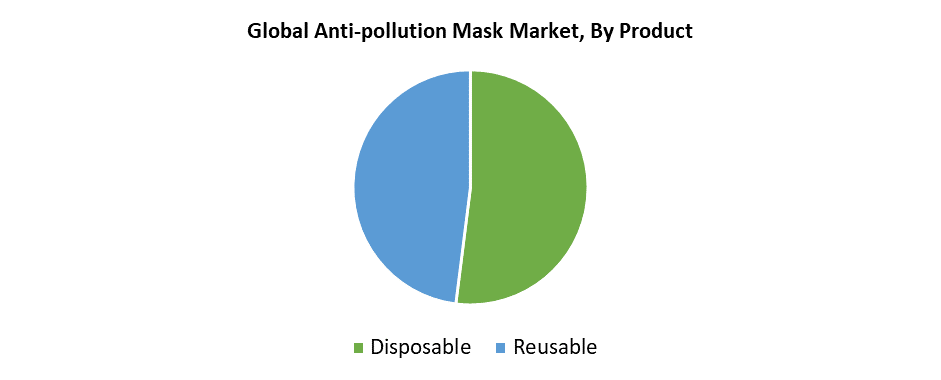
The disposable masks segment dominated the global anti-pollution mask market in 2024 with 52.5% of revenue share. Their broad use in both developed and emerging regions, affordability, and convenience are the main factors driving their expansion. These masks find their primary application as single-use products in densely populated, polluted city areas. The general population and industrial workers, and daily commuters choose these masks because they offer both affordability and easy accessibility and provide effective particulate matter filtering. The worldwide rise in public health awareness due to recent international health emergencies caused a higher demand for disposable masks. Large-scale procurement by governmental and healthcare institutions also helps the segment, enhancing its market position and annual revenue contribution.
The reusable masks segment will show the fastest CAGR during the forecast period because of growing environmental issues, together with customer preference for sustainable options. The reusable masks cost less to users than disposable masks while generating reduced waste, which attracts environmentally conscious customers. Technological progress is driving up the popularity of reusable masks by developing better filtration layers and washable fabrics, along with anti-microbial coatings and changeable filters. The rising popularity of fashionable customized masks attracts younger generations. The sustainable market development receives support from governmental organizations, together with health groups that promote sustainable practices. People worldwide who understand air pollution dangers are driving up demand for sustainable, durable, and effective mask options.
Distribution Channel Insights
The offline distribution sector held the largest revenue share in the global anti-pollution mask market during 2024 because of widespread product use and customer preference for physical store interactions. Pharmacies, along with retail establishments, supermarkets, and specialty health outlets, lead distribution channels because they provide customers with easy access and the ability to physically test multiple mask options. Offline distribution channels provide immediate product access and customized help, especially beneficial for new customers seeking suitable masks with proper filtration features. Established offline distributors serve as preferred channels for institutions and government organizations to purchase large quantities of products. The combination of these factors, together with established relationships and brand recognition, played a crucial role in the segment maintaining its market leadership in 2024.
The anti-pollution mask market's online distribution segment will experience the fastest CAGR during the forecast period because of fast e-commerce development and evolving customer buying patterns. The rapid growth of online sales can be attributed to expanding internet access, together with home delivery convenience and extensive product selections that provide detailed specifications. Customers find value in purchasing products through the platform because they can read customer reviews and access competitive prices and special promotions. Multiple companies now focus on direct-to-consumer (DTC) marketing through digital channels while also promoting their products via social media networks. The COVID-19 pandemic strengthened the ongoing shift toward online shopping, which continues to modify consumer buying habits and drive the growth of digital sales channels.
Regional Insights
The Asia Pacific region dominated the worldwide anti-pollution mask market with the highest revenue share of 33.6% during 2024 because of its dense population and rapid urban growth, along with severe air pollution in major cities. The ongoing air quality problems throughout China, India, and South Korea have driven customers to seek protective respiratory products. The industry growth was supported by health recommendations alongside government regulations, which mandate mask use during high pollution levels. Important manufacturers, together with expanding health awareness and rising disposable incomes, drove higher adoption rates. Domestic manufacturing activities in the region increased while consumer demand grew, which positioned the area as a leading marketplace for anti-pollution masks and earned it the top revenue position.
North America Anti-Pollution Mask Market Trends
The North American anti-pollution mask market accounted for a significant revenue share in the worldwide market in 2024 because people became more aware of air quality problems and airborne disease risks. The market for superior anti-pollution masks experiences growing demand because of strict environmental regulations in the area and rising adoption of preventive healthcare practices. The demand for effective respiratory protection has risen because of ordinary pollutants in urban environments and wildfires affecting selected areas throughout the United States and Canada. The industry gained strength from famous manufacturers and modern developments in protective mask design and filtration systems. The segment achieved substantial revenue growth across the region since customers sought comfortable masks, while online shopping adoption also increased.
Europe Anti-Pollution Mask Market Trends
The anti-pollution mask industry in Europe experienced consistent growth throughout 2024 because urban populations expanded in major cities, while people became more knowledgeable about air pollution health impacts. Protective masks receive wide adoption because European countries, including Germany, France, and the UK, implement strict air quality standards and public health programs. Rising consumer interest in disposable and reusable anti-pollution masks stems from concerns about allergies, industrial emissions, and particulate matter exposure. European consumers who protect the environment choose advanced filtration technologies together with sustainable mask materials. Europe has established itself as a leading force within the international anti-pollution mask industry because of expanding online sales networks and healthcare organization collaborations with manufacturing companies.
Key Anti-pollution Mask Companies:
The following are the leading companies in the anti-pollution mask market. These companies collectively hold the largest market share and dictate industry trends.
- KCWW
- Airhead
- Ohlone Press LLC
- Totobobo (Dream Lab One Pte. Ltd. (Singapore))
- NIRVANA BEING
- MSA
- CAMBRIDGE MASK CO
- 3M
- RESPRO
- idMASK Co., Ltd.
- Others
Recent Developments
- In May 2025, the U.S. Medical Glove Company (USMGC) strengthened the local healthcare supply chain by starting operations at its new face mask manufacturing facility. The facility supports USMGC's mission to manufacture medical supplies in the United States by running six high-speed production lines for 3-ply disposable face masks.
Market Segment
This study forecasts revenue at global, regional, and country levels from 2020 to 2035. Spherical Insights has segmented the anti-pollution mask market based on the below-mentioned segments:
Global Anti-pollution Mask Market, By Product
Global Anti-pollution Mask Market, By Distribution Channel
Global Anti-pollution Mask Market, By Regional Analysis
- North America
- Europe
- Germany
- UK
- France
- Italy
- Spain
- Russia
- Rest of Europe
- Asia Pacific
- China
- Japan
- India
- South Korea
- Australia
- Rest of Asia Pacific
- South America
- Brazil
- Argentina
- Rest of South America
- Middle East & Africa
- UAE
- Saudi Arabia
- Qatar
- South Africa
- Rest of the Middle East & Africa
